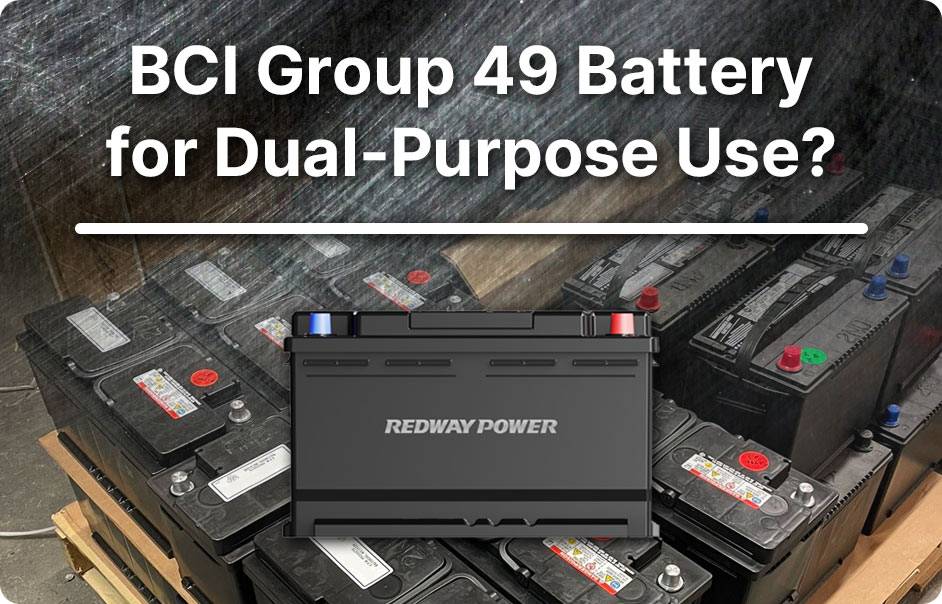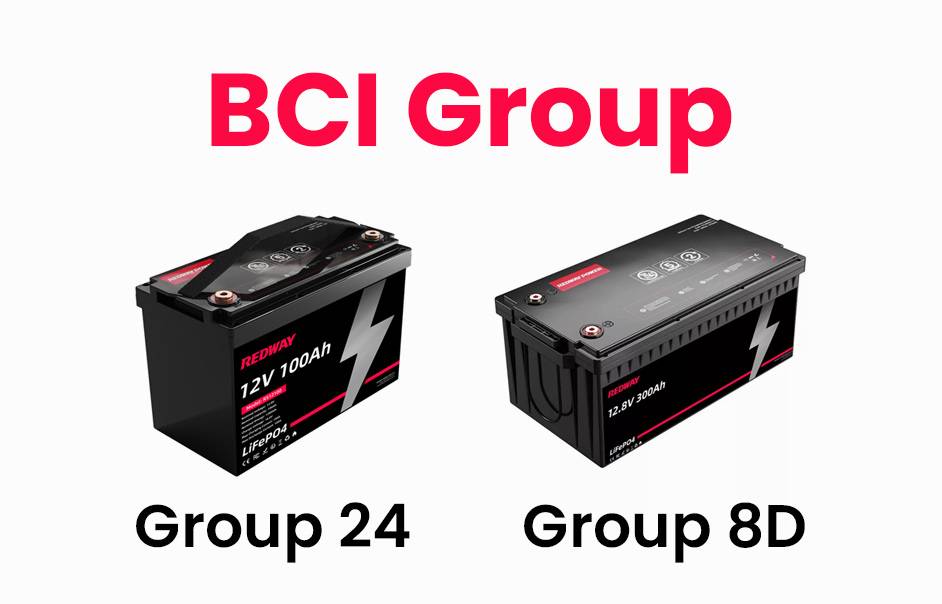- Lithium Golf Cart Battery
- Forklift Lithium Battery
-
48V
- 48V 210Ah
- 48V 300Ah
- 48V 420Ah (949 x 349 x 569 mm)
- 48V 420Ah (950 x 421 x 450 mm)
- 48V 456Ah
- 48V 460Ah (830 x 630 x 590 mm)
- 48V 460Ah (950 x 421 x 450 mm)
- 48V 460Ah (800 x 630 x 600 mm)
- 48V 460Ah (820 x 660 x 470 mm)
- 48V 500Ah
- 48V 560Ah (810 x 630 x 600 mm)
- 48V 560Ah (950 x 592 x 450 mm)
- 48V 600Ah
- 48V 630Ah
-
48V
- 12V Lithium Battery
12V 150Ah Lithium RV Battery
Bluetooth App | BCI Group 31
LiFePO4 Lithium
Discharge Temperature -20°C ~ 65°C
Fast Charger 14.6V 50A
Solar MPPT Charging - 24V Lithium Battery
- 36V Lithium Battery
- 48V Lithium Battery
-
48V LiFePO4 Battery
- 48V 50Ah
- 48V 50Ah (for Golf Carts)
- 48V 60Ah (8D)
- 48V 100Ah (8D)
- 48V 100Ah
- 48V 100Ah (Discharge 100A for Golf Carts)
- 48V 100Ah (Discharge 150A for Golf Carts)
- 48V 100Ah (Discharge 200A for Golf Carts)
- 48V 150Ah (for Golf Carts)
- 48V 160Ah (Discharge 100A for Golf Carts)
- 48V 160Ah (Discharge 160A for Golf Carts)
-
48V LiFePO4 Battery
- 60V Lithium Battery
-
60V LiFePO4 Battery
- 60V 20Ah
- 60V 30Ah
- 60V 50Ah
- 60V 50Ah (Small Size / Side Terminal)
- 60V 100Ah (for Electric Motocycle, Electric Scooter, LSV, AGV)
- 60V 100Ah (for Forklift, AGV, Electric Scooter, Sweeper)
- 60V 150Ah (E-Motocycle / E-Scooter / E-Tricycle / Tour LSV)
- 60V 200Ah (for Forklift, AGV, Electric Scooter, Sweeper)
-
60V LiFePO4 Battery
- 72V~96V Lithium Battery
- Rack-mounted Lithium Battery
- E-Bike Battery
- All-in-One Home-ESS
- Wall-mount Battery ESS
-
Home-ESS Lithium Battery PowerWall
- 24V 100Ah 2.4kWh PW24100-S PowerWall
- 48V 50Ah 2.4kWh PW4850-S PowerWall
- 48V 50Ah 2.56kWh PW5150-S PowerWall
- 48V 100Ah 5.12kWh PW51100-F PowerWall (IP65)
- 48V 100Ah 5.12kWh PW51100-S PowerWall
- 48V 100Ah 5.12kWh PW51100-H PowerWall
- 48V 200Ah 10kWh PW51200-H PowerWall
- 48V 300Ah 15kWh PW51300-H PowerWall
PowerWall 51.2V 100Ah LiFePO4 Lithium Battery
Highly popular in Asia and Eastern Europe.
CE Certification | Home-ESS -
Home-ESS Lithium Battery PowerWall
- Portable Power Stations
BCI Group 49 (H8, L5, 88L5) Batteries Full Coverage
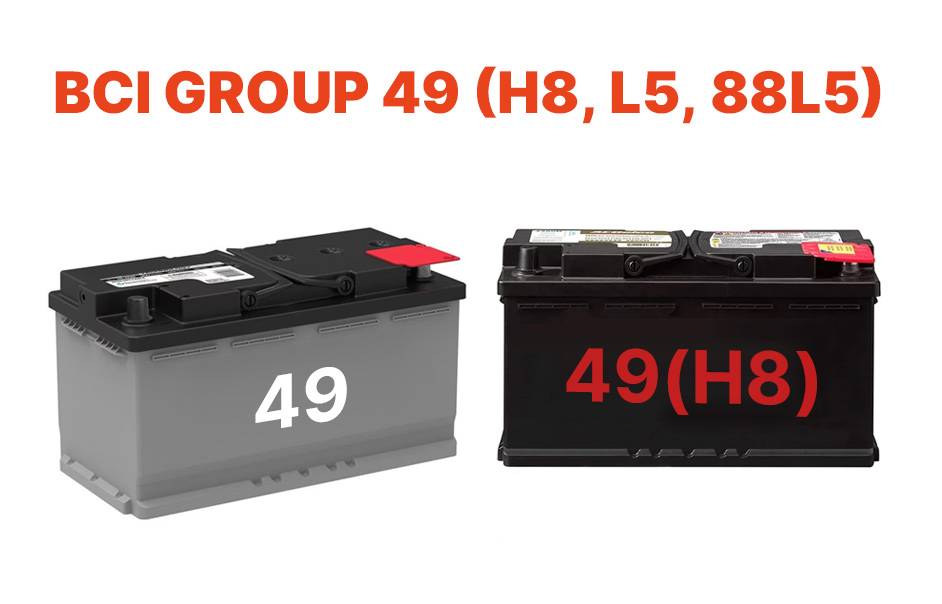
BCI Group 49 batteries are considered equivalent to DIN H8 (L5) and EN 88L5 batteries.
BCI Group 49 batteries typically have physical dimensions of 15 x 6 7/8 x 7 3/16 inches (381 x 175 x 192 mm), while DIN H8 (L5) and EN 88L5 batteries have maximum dimensions of 354 x 175 x 190 mm.
It’s worth noting that there’s a difference of approximately 27 mm (~1.06 inches) in length between these two standards. Battery compartments designed for BCI Group 49 batteries can accommodate DIN H8 (L5) and EN 88L5 batteries, but the reverse may pose challenges.
What are BCI Group 49 (H8, L5, 88L5) Batteries?
BCI Group 49 batteries, also known as H8, L5, or 88L5, are automotive batteries designed for vehicles with high power demands. Featuring a 12-volt nominal voltage, they offer robust starting power and ample electrical energy. Commonly found in cars, trucks, SUVs, and vans, they come in various chemistries, including AGM designs.
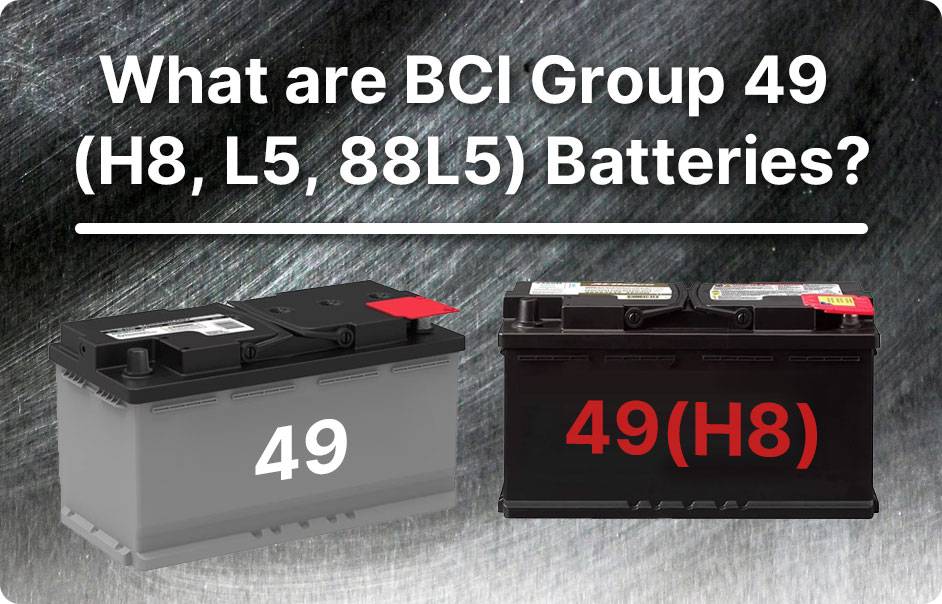
What are advantages of BCI Group 49 (H8, L5, 88L5) Batteries?
The advantages of BCI Group 49 (H8, L5, 88L5) batteries include:
- High Capacity: Group 49 batteries typically offer larger capacity compared to smaller battery groups, providing ample electrical energy for vehicles with high power demands.
- Robust Starting Power: These batteries deliver strong starting power, ensuring reliable engine starts even in challenging conditions.
- Versatility: Suitable for a wide range of vehicles, including cars, trucks, SUVs, and vans, Group 49 batteries are versatile and adaptable to various automotive applications.
- Advanced Technology Options: Some Group 49 batteries feature advanced AGM (absorbed glass mat) technology, providing longer lifespan, better vibration resistance, and enhanced performance compared to traditional lead-acid batteries.
- Compatibility: Group 49 batteries are designed to meet industry standards, ensuring compatibility with vehicles requiring this battery size, providing ease of installation and reliable performance.
Overall, BCI Group 49 batteries offer high capacity, robust starting power, versatility, advanced technology options, and compatibility, making them an excellent choice for vehicles with demanding power requirements.
What devices typically use BCI Group 49 (H8, L5, 88L5) Batteries?
BCI Group 49 (H8, L5, 88L5) batteries are commonly used in a variety of vehicles and applications, including:
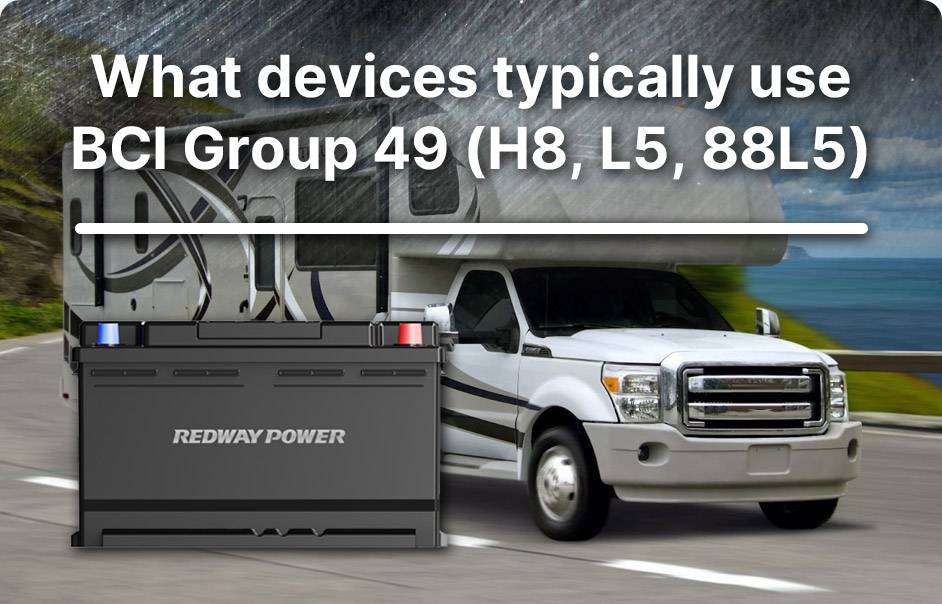
- Cars: Many mid-size to larger cars, particularly those with higher electrical demands or optional accessories, utilize Group 49 batteries for starting power and electrical energy.
- Trucks: Some light and medium-duty trucks, including pickups and delivery vehicles, may use Group 49 batteries to meet their starting and electrical power requirements.
- SUVs: Certain SUVs, especially those with larger engines or towing capabilities, rely on Group 49 batteries to support their electrical systems and ensure reliable performance.
- Vans: Some vans, particularly those used for commercial purposes or passenger transport, may employ Group 49 batteries to provide the necessary power for their electrical systems.
- Marine: Group 49 batteries are also found in marine applications, powering boats and watercraft, particularly those with larger engines or additional electronics.
- Light Industrial Equipment: Certain light industrial equipment, such as utility vehicles and aerial lifts, may utilize Group 49 batteries for their electrical systems.
Overall, BCI Group 49 batteries are versatile and suitable for a wide range of vehicles and applications with moderate to high power demands.
Group 49 (H8, L5, 88L5) for Car Starting Battery
Group 49 (H8, L5, 88L5) batteries are a popular choice for car starting applications, offering an average CCA rating of 900 Amps. Being predominantly Absorbent Glass Mat (AGM) Sealed Lead Acid (SLA) batteries, they deliver robust starting currents and exhibit excellent tolerance to deep discharges. While often labeled as starting/cranking batteries, they function as dual-purpose batteries, boasting a Reserve Capacity of at least 160+ minutes and enduring multiple charging/discharging cycles typical for lead-acid batteries. Consequently, Group 49 (H8, L5, 88L5) batteries find utility not only in automotive contexts but also in marine and light-industrial applications.
Group 49 (H8, L5, 88L5) for Backup Sump Pump Battery
Group 49 (H8, L5, 88L5) batteries aren’t typically designed for deep discharge use, especially for deep discharge cycle applications. However, in emergencies, when a backup sump pump battery fails during a power outage, Group 49 batteries can serve as a temporary solution. Here are some considerations:
- A deeply discharged Group 49 battery may not have enough power to start an engine and must be recharged first.
- Standard sump pump backup batteries typically range from 75 to 100 Ah. Depending on usage, a fully charged Group 49 battery can last for hours or even days.
- Most Group 49 batteries feature SAE automotive battery terminals, while others use M6/M8 bolts.
- Deep discharge applications may shorten the lifespan of dual-purpose and starting Group 49 batteries.
Although not ideal, a fully charged Group 49 battery from a car or truck can be a lifesaver when no other options are available.
Best Sellers of BCI Group 49 (H8, L5, 88L5) Batteries in 2024
Below is a chart detailing some of the most popular Group 49 batteries along with their key features:
| Model | Battery Type Cell Type | Capacity (Ah) RC (min) | CCA MCA | Weight (lbs/kg) Review |
| ACDelco 49AGM Professional | Starting AGM |
95 160 |
900 – |
58.6 lbs; 26.6 kg – |
| Bosch S6588B S6 Flat Plate AGM Battery | Starting AGM |
92 160 |
850 – |
61.9 lbs; 28.1 kg – |
| Deka 9AGM49 AGM Intimidator Battery | Starting AGM |
92 170 |
850 975 |
58.5 lbs; 26.5 kg – |
| Delphi BU9049 MaxStart | Starting AGM |
92 170 |
850 – |
58 lbs; 26.3 kg – |
| Duracell AGM49 Battery | Starting AGM |
92 170 |
850 975 |
57.8 lbs; 26.2 kg – |
| Exide Edge FP-AGML5/49 Flat Plate AGM | Dual Purpose AGM |
92 160 |
850 – |
59.8 lbs; 27.1 kg – |
| Full River FT890-49 | Dual Purpose AGM |
80 168 |
890 1070 |
61.1 lbs; 27.7 kg – |
| Interstate MTX-49/H8 | Starting AGM |
95 160 |
900 1000 |
59 lbs; 26.7 kg – |
| Odyssey 49-950 Performance | Dual Purpose AGM |
94 160 |
950 1150 |
62.8 lbs; 28.5 kg – |
| Weize Group 49 Battery | Dual Purpose AGM |
95 160 |
900 – |
56.43 lbs; 25.56 kg – |
| XS Power D4900 | Dual Purpose AGM |
80 169 |
– 1075 |
59 lbs; 26.8 kg – |
Please note:
In the ‘Model’ column, Amazon affiliate links open in new windows for the most up-to-date prices and offers.
BCI Group 49 (H8, L5, 88L5) batteries typically offer a nominal capacity ranging from 80 to 95 Ah, 850 to 950 CCA, 975 to 1150 MCA, and RC values between 160 and 170 minutes.
Manufacturers such as ACDelco, Bosch, and Deka produce robust starting group 49 batteries, while Exide and Odyssey offer strong dual-purpose batteries suitable for deep discharge applications as well.
The XS Power D4900 battery is a versatile dual-purpose option capable of delivering ample current, primarily designed to power car audio systems and similar accessories when the engine is off.
FAQs
What are the size differences between Group 49 and Group H8 batteries?
How should Lithium Group 49 batteries be recharged?
How long to recharge a 90 Ah battery at 50% DoD?
What charger should be used for a Group 49 battery?
How to charge a Group 49 (H8, L5, 88L5) battery?
Can Group 49 batteries be used as backup sump pump batteries?
How are Group 49 batteries used in vehicles and other applications?
What are recommended AGM batteries for starting and dual-purpose?
More FAQs
What vehicles commonly use BCI Group 49 (H8, L5, 88L5) batteries?
BCI Group 49 batteries are commonly used in a variety of vehicles such as mid-size to larger cars, light trucks, SUVs, vans, and marine vessels.
What are the typical specifications of BCI Group 49 batteries?
BCI Group 49 batteries typically offer a nominal capacity ranging from 80 to 95 Ah, 850 to 950 CCA, 975 to 1150 MCA, and RC values between 160 and 170 minutes.
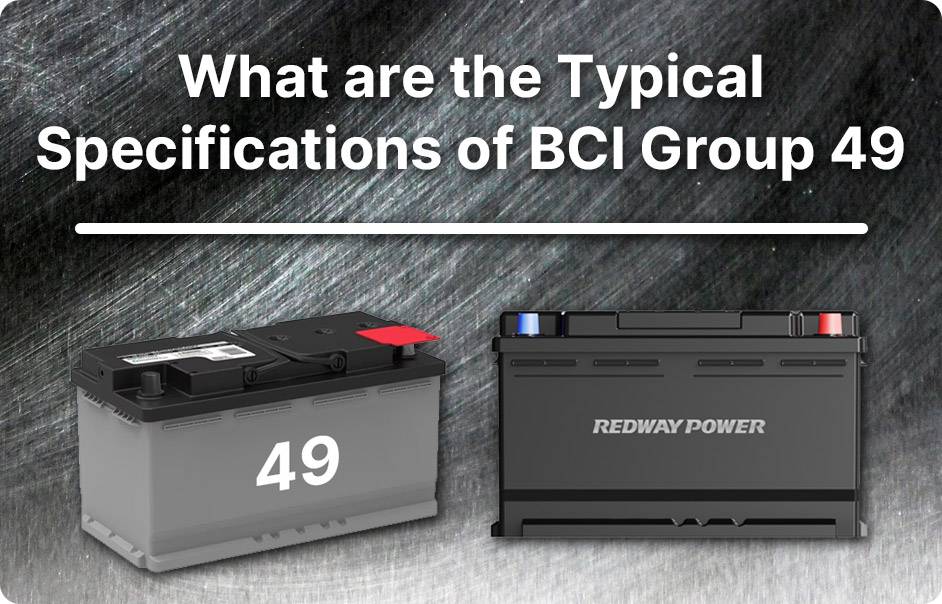
Which manufacturers produce BCI Group 49 batteries?
Many reputable manufacturers produce BCI Group 49 batteries, including ACDelco, Bosch, Deka, Exide, and Odyssey. Additionally, numerous Chinese manufacturers, such as Redway Power, offer BCI Group 49 batteries, providing a wide range of options for both robust starting and dual-purpose applications.
What is the primary use of BCI Group 49 batteries?
BCI Group 49 batteries are primarily used for starting power and electrical energy in vehicles with moderate to high power demands, including cars, trucks, SUVs, and vans.
Are BCI Group 49 batteries suitable for deep discharge applications?
Some BCI Group 49 batteries, particularly those offered by Exide and Odyssey, are suitable for dual-purpose applications, providing strong starting power and deep discharge capabilities.
What is a notable example of a BCI Group 49 battery for dual-purpose use?
The Redway Power G49 battery is a versatile dual-purpose option within the BCI Group 49 category, capable of delivering ample current for car audio systems and accessories when the engine is off.
